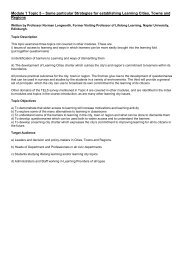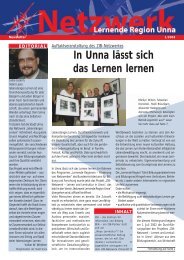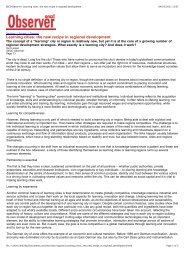SWOT-analysis as a basis for regional strategies - EUROlocal
SWOT-analysis as a basis for regional strategies - EUROlocal
SWOT-analysis as a basis for regional strategies - EUROlocal
You also want an ePaper? Increase the reach of your titles
YUMPU automatically turns print PDFs into web optimized ePapers that Google loves.
There<strong>for</strong>e, in analysing public developmental programmes and the strategic<br />
instruments they encomp<strong>as</strong>s, all these limitations should be taken into account. The<br />
outcomes of the public programming processes are <strong>strategies</strong>, at le<strong>as</strong>t in a broad sense<br />
of the word, and are used de facto <strong>as</strong> such. However, they tend to be <strong>strategies</strong> that<br />
may have few things in common with what is referred to <strong>as</strong> a strategy in strategic<br />
management literature. This is valid also with regard to technical but still highly<br />
important parts of strategy documents, such <strong>as</strong> the <strong>SWOT</strong> <strong>analysis</strong>.<br />
The table below compares and contr<strong>as</strong>ts the key characteristics of public and private<br />
sphere <strong>SWOT</strong> analyses. It should however be emph<strong>as</strong>ised that these are<br />
simplifications or ideal types of strategy <strong>for</strong>mation. As w<strong>as</strong> argued earlier,<br />
traditionally distinctive borderlines between public and private organisations have<br />
gradually become more blurred. Public organisations are now expected to aim at<br />
traditional private sector goals such <strong>as</strong> economic efficiency and growth, whilst private<br />
sector organisations are incre<strong>as</strong>ingly being faced by some of the traditional public<br />
sector politico-normative concerns (openness, accountability, ethical standards).<br />
Table 5. Strategic planning in the public and private spheres: the central features<br />
PUBLIC<br />
Culturally determined, environmentsecuring<br />
(à la Ansoff)<br />
Constrained by regulatory and fiscal<br />
resource b<strong>as</strong>es<br />
High dependence on political and<br />
administrative relations<br />
Predominance of politically determined<br />
goals<br />
Internal adaptation of secondary<br />
importance<br />
Strategies mainly <strong>for</strong> external use<br />
Strategies viewed <strong>as</strong> a tool <strong>for</strong> normative<br />
and political goal-setting<br />
Parts of strategy used <strong>as</strong> a tool of imagebuilding<br />
Open access to <strong>strategies</strong><br />
Strategy <strong>for</strong>mation in wide partnership<br />
Stakeholders difficult to discern<br />
Political construction of a strategy<br />
Formulation and implementation<br />
structures not necessarily convergent<br />
PRIVATE<br />
Culturally determined, environmentsecuring<br />
(à la Ansoff)<br />
Adaptable<br />
Low dependence on political and<br />
administrative relations<br />
Predominance of economic profitabilityoriented<br />
goals<br />
Strategic management aiming at adapting<br />
to external changes through internal<br />
adaptation<br />
Strategies mainly <strong>for</strong> internal use<br />
Strategies viewed <strong>as</strong> a tool <strong>for</strong> economic<br />
goal-setting<br />
Parts of strategy used <strong>as</strong> a tool of imagebuilding<br />
Limited access to <strong>strategies</strong><br />
Strategy <strong>for</strong>mation in a limited<br />
partnership<br />
Stakeholders e<strong>as</strong>ily discernible<br />
Technical construction of a strategy<br />
Formulation and implementation<br />
structures convergent<br />
27
















